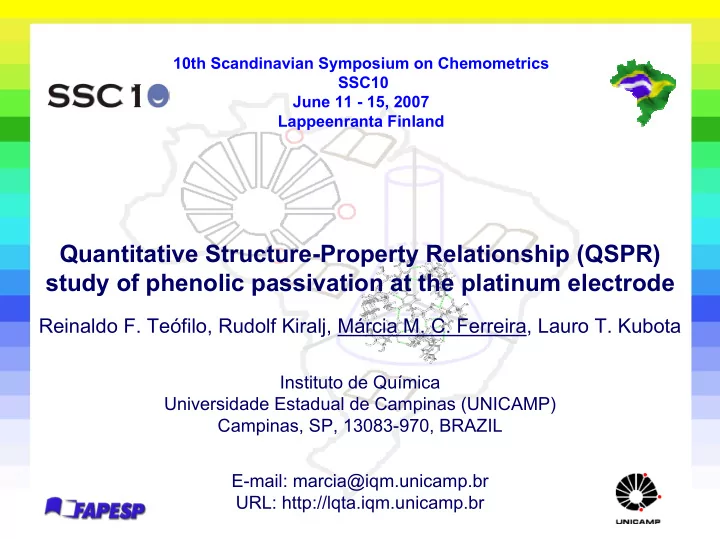

10th Scandinavian Symposium on Chemometrics SSC10 June 11 - 15, 2007 Lappeenranta Finland Quantitative Structure-Property Relationship (QSPR) study of phenolic passivation at the platinum electrode Reinaldo F. Teófilo, Rudolf Kiralj, Márcia M. C. Ferreira, Lauro T. Kubota Instituto de Química Universidade Estadual de Campinas (UNICAMP) Campinas, SP, 13083-970, BRAZIL E-mail: marcia@iqm.unicamp.br URL: http://lqta.iqm.unicamp.br
OUTLINE INTRODUCTION EXPERIMENTAL AND THEORETICAL METHODS RESULTS AND DISCUSSION CONCLUSIONS
INTRODUCTION natural and bioactive compounds chemicals Phenols are of interest as industrial products pollutants and drugs OUR MAIN INTEREST: To use electroanalytical methods to degradate phenols in waste water treatments. Instead of total decomposition, many phenols partially oxidize and then polymerize at the electrode surface. The electrode becomes inactive and in some cases hard to be recuperated. PASSIVATION
Passivation is affected by experimental conditions: Solvent pH electrode material current oxidation potential phenol concentration and structure Mechanism of the first phenolic electrooxidation: A) adsorption at the electrode surface B) O-H bond polarization and oxidation with O-H dissociation C-F) stabilization of the phenoxyl radical by resonance Mechanism is based in the analysis of the polymeric film NO ATTENTION HAS BEEN PAID TO THE MONOMER!
GOAL To propose a Quantitative Structure-Property Relationship (QSPR) which correlates structural properties of phenols with their passivation ability at a polycrystalline platinum electrode.
STUDIED PHENOLIC COMPOUNDS sites for nucleophilic aromatic substitution Chemical reactivity is proportional to the number of these sites (NU).
EXPERIMENTAL PART Chronoamperommetry: The current density j in electrooxidation was scanned for 90 s and recorded each 0.2 s, with the potential fixed at 50 mV above the oxidation peak of a particular phenolics. PASSIVATION ABILITY = current density difference ∆ j for 15 s and 90 s in its logarithmic form y = log( ∆ j / mA cm -2 )
EXPERIMENTAL RESULTS The current density difference ∆ j is related to the chemical reactivity of the phenolic rings (the NU number).
THEORETICAL METHODS Molecular modeling: Experimental crystallographic geometries were extracted from the Cambridge Structural Database (CSD) and optimized at the DFT level, using the B3LYP method and 6-31G** basis set. Molecular descriptors: Optimized geometries were used to generate various quantum chemical descriptors of steric and electronic nature. Other descriptors (compositional, topological and mixed) were obtained manually and by using the Dragon software . Total descriptors: 700
CHEMOMETRICS Variable selection 30 descriptors selected y - X correlation coefficient < 0.5 Manual selection in order to achieve descriptors ☺ with the best predictive ability ☺ differently obtained/defined ☺ computationally simple ☺ chemically interpretable 5 descriptors selected Regression analysis PLS model on autoscaled descriptors Validation: external validation Y-randomization Prediction (4 samples in the prediction set).
FIVE SELECTED MOLECULAR DESCRIPTORS HBD/N → a hydrogen bonding descriptor : the number of polar hydrogen atoms divided by the number of non-hydrogen atoms. Higher values result in weaker passivation Presence of polar groups can partially inhibit phenolic polymerization
Mor06u → Bulky groups hinder the OH group for chemical reactions Mor06u → a steric descriptor (size/shape) defined and calculated by and disable the phenolic skeleton to become parallel to the electrode Dragon Soft. surface and interact with Pt atoms. Ar → a modified Julg’s aromaticity index : calculated from the phenolic C-C bond lengths. Higher ring’s aromaticity is related to higher passivation which means weaker electron delocalization between the ring and phenolic oxigen
Qcnpa → the NPA atomic charge of the phenolic carbon atom. It directly reflects the electronic properties of the OH group. QNUnpa → the sum of NPA atomic charges at the sites for nucleophilic aromatic substitution (including halogen-occupied sites). More negative the sum → higher passivation. This descriptor is directly related to the number of sites for nucleophilic substitution.
EXPLORATORY ANALYSIS Hierarchical Cluster Analysis They have bulky or electronegative substituents and no sites for nucleophilic substitution
THE PLS MODEL (20 samples) The y variable: y = log( ∆ j / mA cm -2 ) Regression vector: The model’s basic statistics: HBD/N: -0.276 1 LV Mor06u: 0.201 Leave-one-out crossvalidation: Qcnpa: 0.279 SEV = 0.097 Q 2 = 0.786 Ar: 0.208 QNUnpa: -0.261 Prediction: SEP = 0.086 R 2 = 0.851 Relative errors: -mean: 5.1% -max.: 13.9% -samples with >10%: 3
External validation Training set: 16 samples External validation set: 4 samples 1 LV (63.5%) SEV = 0.092, Q 2 = 0.817 SEP = 0.078, R 2 = 0.884
Y-randomization test No chance correlation has been found. The randomized models are far away from the real model.
Prediction Predicted values are close to the experimental and predicted values for similar samples from the training set.
CONCLUSIONS To our knowledge, this is the first time that phenolic passivation is studied at a quantitative level (QSPR). The presented QSPR approach is interpretable in terms of chemical concepts. The PLS model can be used for prediction of phenolic passivation in practice, using relatively fast and simple calculations.
Recommend
More recommend